- Industries & Machines Industries & Machines
- IIoT IIoT
- Service-Toll Processing Service-Toll Processing
- Material Material
- News News
- IR Information IR Information
-
Sustainability
Sustainability
Sustainability
- Introduction
- Sustaibality Policy - Mission Statement
- Editorial Policy
- Materiality & Strategy
- Technological contribution to a sustainable global environment
- Contributions towards a safer, more secure and prosperous society
- Sophistication of governance that supports business
- ESG Data Collection
- Sustainable Business Management ~ Finance
- Infromation Disclosure Based on TCFD Recommendations
- Jobs and Careers Jobs and Careers
-
About Us
About Us
About Us
- Corporate Vision
- Greetings (Company Introduction)
- Corporate Overview
- Corporate Profile
- Business Areas and Strengths
- Corporate History
- Hosokawa Micron Group
- Domestic Facilities
- Overseas Subsidiaries (Asia)
- Overseas Subsidiaries (Europe)
- Overseas Subsidiaries (America)
- Asian Agents
- Powder Technology Research Institute
- Industrial Property Rights
- Journals and Books
- Technical Information
- Annual Publication "Micromeritics"
- Compliance Charter
- Privacy Policy
- Cookie Policy
- Quality Principle

Industries & Machines
- TOP
- Industries & Machines
- Machines Search
- ACTIVE FREEZE DRYER AFD[NEW!]
ACTIVE FREEZE DRYER AFD[NEW!]
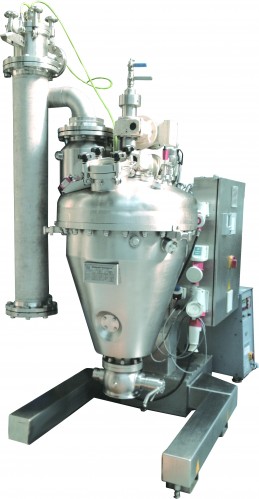
Summary
Freeze drying (lyophilisation) has been used industrially for decades to preserve pharmaceuticals, foodstuffs and organic materials. However, traditional tray-type freeze dryers have proven to be slow and labor intensive. The Hosokawa/Micron Active Freeze Dryer eliminates these drawbacks and is a big step forward in the field of freeze drying bulk solids as well as in powder technology in general.
Active Freeze Drying offers unique possibilities for turning a variety of materials into a fine loose powder in just one single step. Material consistencies include:
• Solutions
• Suspensions
• Pastes • Wet solids
Efficiency, minimal handling and product quality are the key benefits of this new, unique technology. Typical applications include pharmaceuticals like antibiotics, proteins, collagens and API’s. Numerous successful applications are also found in food and food additive applications like herbal extracts, milk derivatives, enzymes, broth extracts, vegetables, lipids, insects, flavors, fibers, proteins and soups.
This new technology has also proven its suitability to the freeze drying of inorganic materials like nano materials, polymers, ceramics, pigments, fillers, lime stone, catalysts, glass powder and metal oxides.
("ACTIVE FREEZE DRYER" is a registered trademark of HOSOKAWA MICRON CORPORATION in Japan)
Principle
In the Active Freeze Dryer, the product is first frozen dynamically in the specially-designed chamber. Whether the material to be dried starts off as a liquid, granular solid or paste, the movement inside the drying chamber ensures that it freezes quickly in the form of free-flowing solid granules. Once the product is fully frozen, a deep vacuum is applied and the sublimation starts. Heat applied to the vessel jacket is effectively distributed throughout the product. The initially coarse, frozen granules gradually shrink as the ice structure connecting the frozen material sublimes, yielding a loose powder consisting of fine, dry particles.
As the solvent disappears, the product temperature starts to rise until it equals the jacket temperature. This marks the end of the drying process. Once the vacuum has been broken, the chamber is opened and the powdered product can be discharged.
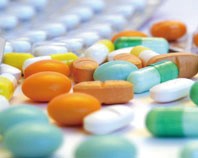
Fig.1 Pharmaceutical tablets
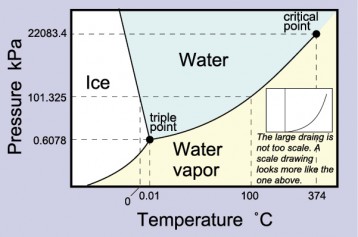
Fig.2 Phase diagram of water
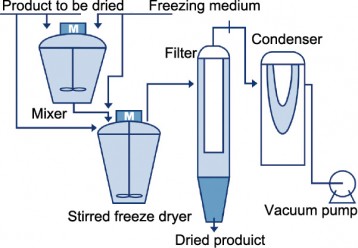
Fig.3 Flow
Features
Efficient and contamination-free

Fig.4 Effect of product shape on dryer type
The Active Freeze Drying process is faster and less labor intensive than the traditional tray freeze drying process. This new process produces lump free, free-flowing powders in one single step. Consequently, the handling is significantly shorter and simpler, and perhaps more importantly: there is hardly any room for contamination which is ideal for sterile materials.
High Quality
Due to this alternative and much faster method of freezing the substrate, the structure of the end product is different and in the majority of cases, will result in an porous structure with better redispersibility and free-flowing properties. In addition to this, the particle size of the final product is often extremely fine and uniform.
Compact
The Active Freeze Dryer is a compact piece of equipment that requires much less floor space than conventional tray drying installations which usually comprise of horizontal vessels, freezer and tray handling machinery. Hosokawa has converted all of this into a single vertical dryer.
Active Freeze Dryers are available with vessels of 1 up to 1,000 liters.
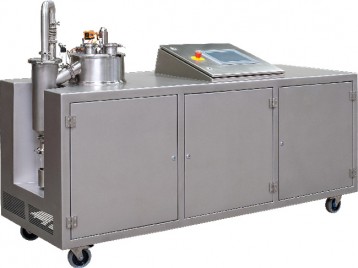
Fig.5 Laboratory model, AFD-1L

Feel free to contact us. if you have any questions or concerns.

